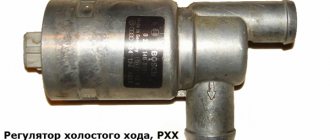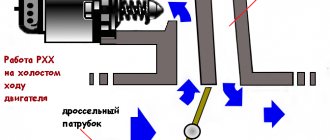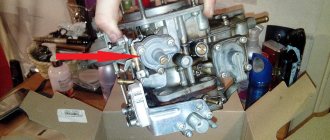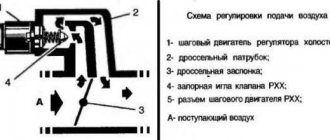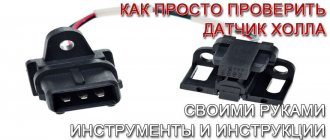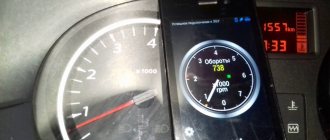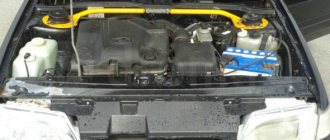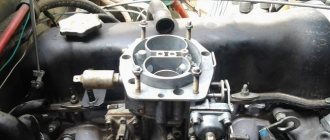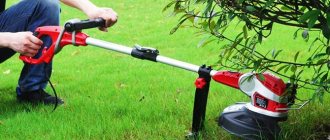I recently came across a problem that at first puzzled me. By coincidence, the car sat outside for 2 weeks and did not start during all this time.
And today I tried to start it, and what did I see? After starting it, the cold speed, as usual, jumped to 1500 rpm. but after 2 seconds they immediately dropped to 800 rpm. Further, as the car warmed up, the revolutions gradually dropped until they dropped to zero (sometimes jumping from 0 to 400 rpm). BUT
all this time the engine worked properly, smoothly reducing speed. That is, it did not choke, did not try to stall, and even when the revolutions dropped to 0, the car was at “P” and was ready to go. That is, the engine did not “troil”, but worked at minimum speed.
Removing the terminal did not help. Progazovka too. My first thought is that there must be something wrong with the sensor. Because the car doesn’t stall, and what’s more, it doesn’t even start. On the tachometer, the revolutions dropped to 0 when it warmed up, but it continues to rumble smoothly and does not choke...
I immediately began to remember what I had been doing in recent days... It seemed like nothing except the Automatic Window Closer.
In general, at first I was of course upset, but the problem was identified fairly quickly. Thanks Drive2.ru))
The problem was with the on-board computer. After I removed the battery terminal a couple of days before (when I was making the auto-closer), the on-board driver reset the settings to zero. And the car just needed to be trained to XX speed.
I taught it like this: 1. on. ignition. pump the gas pedal a couple of times 2. turn off the ignition. 3. on ignition. pump the gas pedal a couple of times 4. turn off the ignition. 5. start the (already warmed up) car and hold the accelerator for 5-10 minutes at 1600-1800 rpm (teach it warm-up, and then it will understand on its own). 6. release the accelerator - the speed should be set at 600-650 rpm (as in the alphabet for a car).
Points 1 and 3 - so that the computer understands in which positions the damper is open and in which it is closed.
PS If you have previously experienced problems with speed, then before this procedure you can clean the throttle body and auxiliary gears.
This algorithm worked on my car (corolla e12, 2006, 1.6 110l/s). I collected it from several different algorithms from the Internet.
Do everything important without load (lights, stove, etc.). And after all the training, it is advisable to ride 5 km, periodically loading the system with devices (to be sure).
While operating a car, drivers have to face various problems. One of the malfunctions, which is quite widespread, is the constant maintenance of high engine speeds. That is, even at idle, the engine speed does not drop. This problem can occur in both injection and carburetor engines, but the reasons will be different. In this article, we will look at what malfunction this problem is a symptom of, and how you can get rid of it.
How to determine that the revolutions are jumping
If the motor is not working properly, the speed will be unstable. At idle, the tachometer may show first 400, and then immediately 800 revolutions, after which it drops again. Jumps can be triggered by turning on the air conditioner or turning on the stove at full power. It often happens that at idle the speed is maintained without jumps, but when you turn on the heater or air conditioner, the speed drops to 500 and the engine even stalls. In addition to the tachometer readings, a problem with speed can be easily diagnosed by fuel consumption, jerks during uniform movement and failures when trying to accelerate. You should also try to listen to the noise of the engine; it can work either louder or quieter.
Description of the problem
When starting the engine, the speed rises to approximately 1500 RPM at idle. After the engine warms up, they drop to approximately 650-950 RPM, which is the norm. If after warming up the speed remains at the same level, then the engine is not working correctly.
The second option, when a defect occurs, is that the car does not fall when the gas is released while driving, that is, when braking with the engine and coasting. In this case, the speed seems to “freeze” at a level above 1000 RPM until the car comes to a complete stop, although in working cars it should fall below the specified mark.
Determining that a car is running at high speeds is quite simple. If the car's dashboard is equipped with a tachometer, then the increased speed is displayed on it. In the case where there is no tachometer, the increased speed can be determined by the sound of the engine. The greater their number, the higher the tonality and louder the sound of the engine.
The main reasons for speed surges
Modern cars are equipped with many different sensors and controllers. The electronic engine management system collects data from sensors, processes it, and controls it based on this data, so that the warmed-up engine maintains stable speed. However, the malfunction of one of the sensors or controllers always leads to incorrect control of the motor, although the engine itself is working properly. However, the malfunction may not lie in the engine management system; mechanical failures, including poor condition of the fuel or air filters, can also lead to them.
Low idle speed on a warm engine can be caused by both serious problems with the engine and minor ones.
- Due to a not too tight connection in the intake pipe, air is sucked in from the external environment.
- Failure of injectors.
- Problem with spark plugs.
- Due to improper operation of the fuel pump, fuel is supplied at low pressure.
- Poor quality gasoline.
- The crankcase ventilation system is no longer sealed.
- Damage to the electronic engine control unit.
- Malfunction of the throttle valve sensor.
- Broken idle speed sensor.
- The crankshaft position sensor does not work.
- Violation of valve timing.
- The gasoline pressure regulator does not work.
Any breakdown from this list can result in the speed fluctuating when the engine is warm. Not everyone can cope with this problem on their own; it depends on your skills and understanding of the operation of engine systems. However, so that at the service station you are not “hyped” for unnecessary and unnecessary replacement of parts, you should try to figure out the reason for the jumps in speed yourself. If you are inclined to suspect that the speed is not maintained due to low-quality fuel, then try refueling at another gas station. If this is the reason, then after refueling with good fuel the malfunction will disappear.
Ways to eliminate the “sore”
If such a problem occurs, you need to look for which node is to blame analytically, checking all the specified sensors.
First, let's consider the following option for correcting the problem situation. Let's assume that a VAZ 2110 has high revs. An examination of the suspected components for faulty components showed that the throttle position sensor has traces of rust. It is located directly above the throttle valve. Measurements with a voltmeter showed that when the engine is idling, the voltage on it remains high - which means it does not close the damper.
How to fix the problem? For this we only need a screwdriver. Let's begin the procedure.
- By disconnecting the terminal block and also unscrewing two screws, we dismantle the assembly.
- We notice that traces of rust inside interfere with the movement of the wheel that regulates the position of the damper.
- We fill the insides of the defective device with a penetrating anti-rust aerosol.
- Use a development screwdriver to turn the wheel.
- We reassemble in reverse order.
Check to see if the engine idle speed is now high. The problem should go away.
Now let's look at another case. Let's say we have high idle speed in a VAZ 2114. This is what we do when faced with this situation.
When clarifying the circumstances of the problem under investigation, we always initially check the operation of the idle speed sensor. This device consists of a needle built inside an electromagnetic coil.
The needle either moves inside the coil, moving away from the hole in the throttle pipe, or moves out, closing this hole, thereby stopping the supply of air for combustion of the mixture.
Also read about and. This element is located at the throttle valve, opposite the gas pedal cable. To diagnose it, we pull out the terminal block from it, start the car, after which we see that we still have high engine speeds that have not changed at idle. Then we remove this defective unit, then clean it or replace it. For work we take:
- screwdriver;
- toothbrush;
- petrol.
Begin.
- Unscrew the two screws. We take out the broken node.
- We connect the wiring to it. Turn on the ignition. If the needle of the device moves slightly inside the coil to the touch, then it is working.
- If the needle does not react when an electric current is applied, wash the device with a toothbrush using gasoline.
- We do the assembly in reverse order.
When you cannot restore the functionality of this unit with your own hands, it is better to purchase a new one. Moreover, the cost of spare parts is low.
Other fixes
Of course, the options considered do not exhaust the possible ways to correct the shortcoming when high speeds are noticed precisely on a warm engine. To further study the most common situations, let's look at the case of a malfunctioning mass air flow sensor. This device is responsible for supplying the correct portions of air for combustion of the mixture, and also provides data to the electronic control unit about these portions, so that the unit proportions the supplied portions of gasoline.
This node can be diagnosed as follows. It is necessary to disconnect the terminal block from our mass flow regulator, and then start the engine, after which it is necessary to drive the crankshaft speed above 2000 rpm.
In this case, the emergency mode is automatically launched, portions of the mixture are now calculated only by the position of the damper. If the sensations show that the car with the disconnected sensor has become more dynamic than with the connected one, then the malfunction of this unit is obvious.
To replace it, take the following tools:
- Phillips screwdriver;
- flat screwdriver.
We are starting renovations.
- After turning off the engine, disconnect the wires from the mass air flow sensor.
- Loosen the clamp and remove the hose on the inlet pipe.
- We dismantle the defective device by unscrewing two bolts.
- We are replacing the device.
- We do the assembly, moving backwards point by point.
This is how this cause of high revs is eliminated.
For some reason it didn't help
Now let's look at another situation. The car owner changed, for example, the idle speed sensor, and the crankshaft speed became high, or remained high as before.
The reasons for this unpleasant phenomenon may be as follows.
- Most likely, the car enthusiast made the replacement just like that, at random, maybe it would stop turning too quickly. The real state of affairs suggests that the fault needs to be looked for elsewhere.
- If this sensor is not a completely new model, it has an adjusting bolt, it may need to be tightened in order to adjust the problem unit. Modern idle air valves do not require any additional adjustment when installed. However, for example, if the Priora has high idle speeds, then you can look for the adjusting screw on this car.
- It is possible that the new spare part was defective.
- The new spare part was installed incorrectly.
Here, perhaps, all the roots of the phenomenon are listed.
Let's talk about cost
Not everyone can afford this type of repair, such as even reinstalling a sensor. Although the main difficulties are caused not so much by replacing one of the sensors involved in the process, but by diagnosing the sources of overestimation of the crankshaft speed when idling. After all, we have found that the search for the causes of this disease is complicated by their diversity.
If a car enthusiast decides to contact a service station with a request to find the cause of high engine speeds at idle, then the cost of diagnostics in major cities of the Russian Federation will be as follows.
| City | Price |
| Moscow | 700 rub. |
| St. Petersburg | 650 rub. |
| Ekaterinburg | 500 rub. |
| Samara | 500 rub. |
| Krasnodar | 550 rub. |
Since the cost of manipulation is low, if a car owner doubts the success of a manual diagnosis, he can safely contact a service station.
Throughout the article, we looked at the main options for solving a common problem. Now, if a car enthusiast encounters an increase in idle crankshaft speed, he will already know what to do.
Now read about and.
Drivers often wonder why the engine speed does not drop at idle. This situation occurs quite often, and neither carburetor engines nor more modern injectors are immune from this. True, the reasons for the malfunction will be different. But, in practice, everything can be diagnosed independently, and on almost all car models the problem can be fixed with your own hands without much difficulty. The most important thing here is to make a correct diagnosis; this will significantly speed up the repair process and save you from additional problems and difficulties.
What to do if the engine speed fluctuates
Some types of repair work can be done independently. Suction of excess air is a minor failure. To understand whether this is the reason, you will need to check how tight the special channels in the cylinder head are. To do this, remove the air hose and see if there are cracks in it. This can be done using an air compressor, which will pump air into the hose, and the hose itself must be placed in a bucket of water. If there are cracks in the hose, bubbles will appear in these places. In this case, it is enough to simply replace the hose.
Increased idle speed on a warm engine can be caused by a clogged crankcase gas ventilation system. To eliminate this possibility, it should be removed and cleaned with a special liquid. After removing the dirt, put it back in place and start the engine.
The proper operation of the idle speed sensor can be checked using electrical measuring instruments. If the device shows a resistance of around 54 Ohms, then everything is fine with it. It is not difficult to assess the serviceability of the fuel filter: remove and assess its condition; if it is clogged, clean it or replace it and put it in place.
If you have a car with a carburetor, then you can also remove it and clean it.
Air leak
Checking the intake manifold for leaks
Excess air leakage can cause high idle speeds. Moreover, depending on where excess air penetrates into the intake manifold, the idle speed will either simply be increased or begin to “float” - rise and fall almost until the engine stops .
If the idle speed “floats”, then most likely there is an air leak in the intake manifold.
If there is simply a violation of the tightness of the intake manifold gaskets, damage to the vacuum hoses or sealing rings, then the speed will “float”. This happens due to the fact that the amount of gasoline supplied to the cylinders will be constant, and the quality of the mixture becomes either “richer” or “poorer”. When a certain critical value (air content in the fuel mixture) is reached, the engine will begin to slow down - until it stops. But as the speed decreases, the amount of air entering the manifold will decrease, i.e. the mixture will become richer and the engine will “come to life” - the idle speed will increase. This will continue until the leak in the intake manifold is eliminated. On turbocharged engines, air leaks can also occur through damage to the intercooler or air pipe connections. If there is significant suction (for example, if the pipe has come off the intercooler), the engine begins to operate with a whistling (or hissing) sound. But sometimes it is possible to identify the location of a violation in the intake tract only by cutting off the air supply to the intake manifold in different places in turn - from the air filter to the manifold itself.
We recommend: Errors 84 and 89 on Chevrolet Cruze: what they mean and how to get rid of them
When to contact specialists
When you have carried out diagnostics and found out that the reason for the jump in speed lies in serious breakdowns, it is better to entrust the repair to specialists. It is impossible to independently cope with replacing sensors in an electronic engine control system without special knowledge. They will be replaced at the service station.
The same goes for the throttle valve: it should be replaced by professionals. If it is in good condition and you just need to wash it, then you can do it yourself: to do this, you need to pull out the hoses and pour cleaner into the throttle itself. Just remember to disconnect the electrical contacts from the damper.
Many motorists have experienced the effect of a drop in idle speed on their car. Often, this leads to the engine stalling altogether. This effect has many causes that need to be addressed urgently so as not to cause even bigger problems.
Basic problems with an engine with a carburetor power supply system
- The location of the needle valve, which is responsible for adjusting the gasoline level in the float chamber.
- The throttle valve does not close tightly, which often happens when it is clogged or mechanically damaged. A dirty damper should be cleaned with a special product that can be purchased at an auto parts store. And in case of mechanical damage to this unit, most often, a complete replacement of the carburetor is required.
- Incorrect adjustment of the XX system. This problem often appears after cleaning or replacing the carburetor. To eliminate it, you just need to adjust it, ensuring the optimal ratio of gasoline and air in the fuel-air mixture.
- Consistently high idle speeds may indicate that the throttle valve located in the primary chamber is not tightly closed. This problem occurs due to wear of the throttle valve drive cable or deformation of the valve itself.
- Damage to the intake manifold or wear of the gasket between the cylinder head or carburetor.
In the case of an injection power system, there are much more possible reasons for the increase in idle speed. This is due to the fact that they can be associated both with the failure of mechanical components and with the malfunction of electronic sensors.
What are the reasons for the drop in turnover?
Many car enthusiasts do not pay attention to the condition of their cars, much less the engine. Often, the consequences can be expressed in malfunctions, which will develop into major repairs, which will cost a considerable amount of money . It is for these reasons that if a malfunction occurs with the engine, it is necessary to return it to normal functionality.
So, let's look at the main reasons that lead to low idle speed:
- The adjustment of the “quantity” and “quality” screws is broken
A common cause of low idle speed on Ozone carburetors. Often, tightening the fuel adjustment screws is enough to restore normal speed.
- Fuel level is incorrectly adjusted
Basic problems with an engine with a carburetor power supply system
- The location of the needle valve, which is responsible for adjusting the gasoline level in the float chamber.
- The throttle valve does not close tightly, which often happens when it is clogged or mechanically damaged. A dirty damper should be cleaned with a special product that can be purchased at an auto parts store. And in case of mechanical damage to this unit, most often, a complete replacement of the carburetor is required.
- Incorrect adjustment of the XX system. This problem often appears after cleaning or replacing the carburetor. To eliminate it, you just need to adjust it, ensuring the optimal ratio of gasoline and air in the fuel-air mixture.
- Consistently high idle speeds may indicate that the throttle valve located in the primary chamber is not tightly closed. This problem occurs due to wear of the throttle valve drive cable or deformation of the valve itself.
- Damage to the intake manifold or wear of the gasket between the cylinder head or carburetor.
In the case of an injection power system, there are much more possible reasons for the increase in idle speed. This is due to the fact that they can be associated both with the failure of mechanical components and with the malfunction of electronic sensors.
Approaches to solving the problem
When all the causes have been identified, you can proceed to troubleshooting. Of course, there are a different number of ways to solve the problem, but do not forget that a certain sequence of actions is necessary. It is worth considering the issue in more detail.
Adjust fuel level and idle speed
Adjusting the idle speed on Ozone carburetors. You will need a tachometer and a slotted screwdriver. Work must be carried out on a warm engine. By turning the “quantity” screw in the clockwise direction, you can achieve an increase in speed.
If it is not possible to solve this problem with one “quantity” screw, you need to connect a “quality” screw, which, if it has not been used yet, may have a factory plug on it. It can be pulled out by screwing a suitable screw into the plastic and pulling it out.
Adjustment is usually carried out in 2-3 (several) passes.
Replace spark plugs
Even if the spark plugs have recently been replaced, they may be of poor quality or defective. Original spare parts are always better than cheaper analogues. A falling XX often hints at this malfunction.
Change fuel
Using sensors, it is necessary to check the pressure in the fuel supply system and the presence of contaminants. After which you need to change the fuel to a cleaner and higher quality one. As a last resort, you should consider refueling at a gas station of another company.
Check air and fuel filters
The air filter may be dirty. As the filter becomes dirty, the amount of air entering the engine decreases. Engine power decreases and fuel consumption increases significantly.
The air filter needs to be cleaned or, more importantly, replaced. It is best to carry out this procedure in advance to avoid other problems in the future.
Clean the idle speed sensor
If oil and other contaminants enter the sensor, it will fail. The sensor is cleaned with carburetor cleaner and aerosol liquid. The device must be removed and washed. The aerosol liquid gently cleans the needle. Be careful that liquid does not get into the inside (that is, under the spring), to avoid its failure.
Carburetors
First, let's deal with the problem on carburetor engines. This type of power supply is considered outdated, but many cars on the road are still equipped this way. Also, many car enthusiasts, for their own ideological reasons, use such engines, and are not going to give them up. Diagnosing the source of the problem here is quite difficult, and this is taking into account the small list of elements that cause an increase in speed. Let's look at what you should pay attention to:
- Needle valve position
. In this case, the fuel does not flow into the chamber. Moreover, depending on the location in which the valve is jammed, idle speed can either disappear or, on the contrary, increase; - Improper adjustment
of the idle air system. This usually happens after cleaning or repairing the carburetor. To avoid problems, the fuel to air supply ratio should be set correctly. If you have not produced it before, then it is better to read how this is done specifically in your version; - Closing problem. There may be several reasons for such a malfunction. Most often, the damper does not close due to the presence of carbon deposits on it. In this case, you will need to clean this node. Usually this helps. In some cases, the throttle valve may be damaged. Then you will need to change this part, but not all carburetors provide this option;
- Sometimes, the problem can manifest itself when, this happens quite rarely. But it's still better to check. To do this, open the radiator cap with the engine running; if the gasket is burnt out, white smoke will come out of the neck. In this case, you will need to change the gasket;
- Open suction
. Check how the damper in the primary chamber works. If you have identified a problem, then it makes sense to look at how the suction works. Most often, to fix the problem, it is enough to simply lubricate the cable and the damper drive.
In addition, the gas pedal may jam. This situation can happen not only on carburetors, but also on injectors. Be sure to check if the pedal moves freely.
Conclusion
A drop in engine speed is a fairly common problem. It can happen not only for any one reason - when the engine is severely worn out, an integrated approach is required, and the breakdowns can be quite specific. In this case, you may need to seek professional help.
I recently came across a problem that at first puzzled me. By coincidence, the car sat outside for 2 weeks and did not start during all this time.
And today I tried to start it, and what did I see? After starting it, the cold speed, as usual, jumped to 1500 rpm. but after 2 seconds they immediately dropped to 800 rpm. Further, as the car warmed up, the revolutions gradually dropped until they dropped to zero (sometimes jumping from 0 to 400 rpm). BUT
all this time the engine worked properly, smoothly reducing speed. That is, it did not choke, did not try to stall, and even when the revolutions dropped to 0, the car was at “P” and was ready to go. That is, the engine did not “troil”, but worked at minimum speed.
Removing the terminal did not help. Progazovka too. My first thought is that there must be something wrong with the sensor. Because the car doesn’t stall, and what’s more, it doesn’t even start. On the tachometer, the revolutions dropped to 0 when it warmed up, but it continues to rumble smoothly and does not choke...
I immediately began to remember what I had been doing in recent days... It seemed like nothing except the Automatic Window Closer.
In general, at first I was of course upset, but the problem was identified fairly quickly. Thanks Drive2.ru))
The problem was with the on-board computer. After I removed the battery terminal a couple of days before (when I was making the auto-closer), the on-board driver reset the settings to zero. And the car just needed to be trained to XX speed.
I taught it like this: 1. on. ignition. pump the gas pedal a couple of times 2. turn off the ignition. 3. on ignition. pump the gas pedal a couple of times 4. turn off the ignition. 5. start the (already warmed up) car and hold the accelerator for 5-10 minutes at 1600-1800 rpm (teach it warm-up, and then it will understand on its own). 6. release the accelerator - the speed should be set at 600-650 rpm (as in the alphabet for a car).
Points 1 and 3 - so that the computer understands in which positions the damper is open and in which it is closed.
PS If you have previously experienced problems with speed, then before this procedure you can clean the throttle body and auxiliary gears.
This algorithm worked on my car (corolla e12, 2006, 1.6 110l/s). I collected it from several different algorithms from the Internet.
Do everything important without load (lights, stove, etc.). And after all the training, it is advisable to ride 5 km, periodically loading the system with devices (to be sure).
Injector
Here everything is much more complicated: the operation of an injection engine is associated with many sensors, ECUs and other elements of the power unit, in particular the fuel system. But first things first.
Idle air control sensor (IAC)
If this device is faulty, the engine may stall at idle, or its speed will float, making jumps in the range of approximately 600-1200 rpm. Therefore, it is necessary to ensure that the device is working properly. This can be done using a multimeter. Procedure:
- First, measure the supply voltage on a pair of outer terminals A and D. To do this, place the black probe of the device to ground (any unpainted metal part of the car body), and the red one to the indicated terminals in turn. When the ignition is on, there should be 12 V. If this is not the case, check the voltage at the ECU terminals (for the VAZ 2110 these are pins 4 and 54). If there is 12 V here, look for an open circuit in the wiring.
- Set the tester to ohmmeter mode. Resistance between terminals A and B, C and D: should be 40-80 Ohms.
- Check the motor for short circuit. To do this, measure the resistance between A and D, B and C: the arrow of the device should tend to infinity.
TPDZ
That is, a throttle position sensor, which is responsible for the amount of fuel mixing with air. If the fuel supply is incorrect, the ECU will automatically give a command and the idle speed will increase. Therefore, it is necessary to check the TPS:
- Unclip the connector that fits the sensor: you will see 3 contacts: for the control signal, power and ground.
- Start the engine and measure the voltage at the power terminal: it should be approximately 5 V.
- Stop the engine and switch the tester to resistance measurement mode (throttle valve closed). Measure it between ground and signal contact: it should be 0.8-1.2 kOhm. When the damper is closed, the value is 2.3-2.7 kOhm.
How to remove and install a new sensor
To dismantle, simply unscrew a couple of mounting screws. Next, disconnect the end of the damper shaft and, rotating the new sensor, align the holes to screw in the screws. Put the connector on.
After completing the work, it is necessary to delete the error from the controller’s memory. To do this, remove the terminals from the battery for a period longer than 8 hours. If the error has not cleared, try driving in a gentle mode so that the ECU resets it itself. If you fail again, you will have to contact a car service (you will need a motor tester).
Throttle valve
Jamming of this mechanical device will result in an increase in the amount of air supplied to the cylinders. As a result, the ECU will work again and begin to increase the volume of fuel to balance the mixture. To solve the problem, remove the damper and clean it with chemicals. If there is no result, the part will have to be replaced.
Engine temperature sensor
As practice shows, this device breaks down quite often, because it is constantly exposed to temperature changes. It needs to be checked:
- Disconnect the block and with the ignition on (no need to start the engine), check the voltage at terminal “B” relative to ground: it should be 5 V. If the value is less than 4.7 V, you need to look for the reason: a break or short to ground is possible.
- Turn off the ignition and determine the resistance between contact “A” and ground: the correct value is 1 Ohm (no more and no less).
- Measure the resistance between ground and terminal “B”: it should be at least 1 Ohm.
- Check the functionality of the sensor. To do this, you need to measure the above resistances on a cold and warm engine. The values must be the same.
After the checks, it is recommended to reset the ECU errors, as indicated above in the section on TPS.
Mass air flow sensor (MAF)
During operation, this device gradually becomes covered with an oil film, which can lead to failure of the hot-wire anemometer, the element responsible for determining the amount of air. If the device does not cope with its task, the ECU receives incorrect information and the engine begins to increase speed.
Increased speed may also be due to a dirty air filter.
Intake manifold
It may have deformation or gasket breakdown. An increase in idle speed indicates an air leak.
To fix the problem you will have to remove the manifold. After dismantling, inspect it carefully: deformation can also affect engine warming up, its starting and other factors. Damage is eliminated by grinding, which is preferable to do in a car service center.
Electronic engine control unit
Incorrect operation of the ECU also affects high idle speeds. To restore the normal functioning of the “brains” you will need a special cable, computer and software.
It is highly not recommended to poke around here on your own: it is better to trust the specialists. In practice, after unprofessional intervention, the “do-it-yourselfers” still have to go to a specialized technical center to eliminate the consequences of their own “improvements.”
Generator
Although rare, it can also cause increased engine speed at idle. Why is this happening? If this unit does not produce enough current, the ECU will command the engine to spin up more strongly to bring the voltage up to normal. As a result, the turnover will increase.
Crankcase ventilation (PCV) system
It is needed to remove crankcase gases through a special valve in order to prevent pressure from increasing above normal.
If you can find the PCV valve, then carefully pinch the tube that fits it with pliers: when the engine is running, the speed should drop slightly. If this does not happen, the device must be replaced.
Turbocharger
Not all cars are equipped with such a “thing,” but it may be the “culprit” for high engine idle speeds, which can “automatically” decrease and increase. Air leaks may occur here due to a leak in the rotor shaft gasket. The same effect can be caused by wear of turbocharger parts (for example, bearings).
We recommend: Is it possible to eliminate the hum in the power steering on your own?
